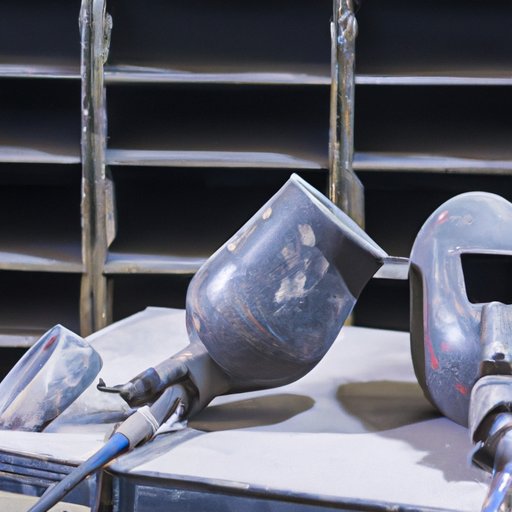Introduction
Sandblasting is a process that involves propelling very fine particles of sand or other abrasive material at high speed against a surface. The process is used to smooth and shape surfaces, remove contaminants, and prepare surfaces for painting. Sandblasting can be used on a variety of materials, including wood, metal, and plastic. In this article, we will focus on sandblasting aluminum.
Aluminum is a lightweight yet strong metal that is used in a wide range of applications, from automotive parts to furniture components. Sandblasting aluminum is an effective way to clean and prepare it for painting or other finishes. It can also be used to create decorative patterns and designs on the surface of aluminum.

How to Sandblast Aluminum for a Professional Finish
Sandblasting aluminum requires specialized equipment and techniques. Before you begin, make sure you have all the necessary equipment, including a sandblaster, protective gear, and proper sandblasting media.
The sandblaster is the most important piece of equipment for sandblasting aluminum. Different sandblasters are designed for different types of jobs, so make sure you choose one that is suitable for your project. You’ll also need to select the right type of sandblasting media. Commonly used media include steel grit, aluminum oxide, and glass beads.
Once you have the right equipment, you can begin the sandblasting process. Start by preparing the surface of the aluminum. Make sure the surface is free of dirt and debris, and use a vacuum cleaner to remove any dust that may be present. Then, apply the sandblasting media to the surface of the aluminum, using a consistent, even pressure.
Once the surface has been sandblasted, use a brush or cloth to remove any remaining dust and debris. Finally, inspect the surface of the aluminum to ensure that it has been properly sandblasted and is ready for painting or other finishing processes.
What You Need to Know Before You Start Sandblasting Aluminum
Before beginning the sandblasting process, there are several considerations to keep in mind. First, make sure you have the right type of sandblasting media for the job. Different types of media produce different results, so choose the one that is best suited for your project.
It is also important to consider the size of the sandblasting nozzle. A larger nozzle will allow you to cover more area at once, but it will also reduce the accuracy of the sandblasting. If you want to achieve a more precise finish, use a smaller nozzle.
Finally, you should take into account the amount of time it will take to complete the sandblasting process. Sandblasting is a time-consuming process, so make sure you factor in the time needed to sandblast each piece of aluminum before you begin.
Safely Sandblasting Aluminum – A Guide for Beginners
Sandblasting aluminum can be dangerous if not done correctly. To ensure your safety, always wear the appropriate protective gear when sandblasting. This includes goggles, gloves, and a face mask or respirator to protect your eyes, hands, and lungs from the sandblasting media.
In addition, make sure you are working in a well-ventilated area. Sandblasting produces dust and debris, which can be hazardous if inhaled. Open windows or use a fan to ensure that the air is circulating properly.
Finally, always follow the manufacturer’s instructions when using a sandblaster. Improper use of a sandblaster can cause serious injury or damage to the surface of the aluminum.

The Benefits and Drawbacks of Sandblasting Aluminum
Sandblasting aluminum offers a number of advantages. It is an effective way to remove dirt, grease, and other contaminants from the surface of aluminum. It is also a fast and efficient way to prepare aluminum for painting or other finishes. Sandblasting can also be used to create decorative patterns and designs on aluminum.
However, there are also some drawbacks to sandblasting aluminum. Sandblasting can be messy and time consuming, and it can be difficult to achieve a uniform finish. In addition, sandblasting can be dangerous if not done correctly, so it is important to take the necessary safety precautions.

An Overview of the Steps Involved in Sandblasting Aluminum
Sandblasting aluminum requires several steps. First, you must prepare the surface of the aluminum. This involves removing any dirt, grease, or other contaminants from the surface. Once the surface is clean, you can begin the sandblasting process.
Next, you will need to apply the sandblasting material. Use a consistent, even pressure to ensure that the entire surface is covered. Finally, use a brush or cloth to remove any remaining dust and debris from the surface. Once the surface is clean, it is ready for painting or other finishing processes.
Sandblasting Aluminum: What Are the Best Practices?
Sandblasting aluminum requires careful planning and preparation. To achieve the best results, choose the right sandblasting media for your project. Different types of media produce different results, so make sure you select the one that is best suited for your needs.
In addition, make sure you are using the right type of sandblaster for the job. Different sandblasters are designed for different types of projects, so choose one that is suitable for your project. Finally, always wear the appropriate protective gear when sandblasting, and follow the manufacturer’s instructions for safe and effective use of the sandblaster.
Conclusion
Sandblasting aluminum is an effective way to clean and prepare aluminum for painting or other finishes. However, it is important to take the necessary safety precautions when sandblasting, and to choose the right sandblasting media and equipment for the job. With the right equipment and technique, you can achieve professional results when sandblasting aluminum.

